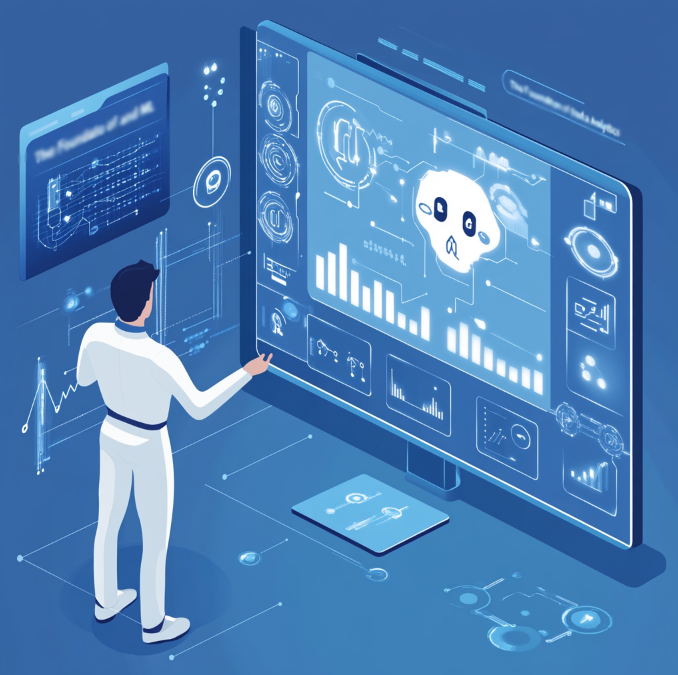Artificial Intelligence (AI) and Machine Learning (ML) have revolutionized the way organizations analyze data, uncover insights, and make decisions. An AI platform serves as a comprehensive, integrated framework that supports the entire machine learning lifecycle, from development to deployment and monitoring, ensuring compatibility with existing infrastructure and seamless integration of AI models into business operations. These technologies enable businesses to process vast amounts of data in real time, identifying patterns and trends that were previously impossible to detect. Data pipelines are essential for enabling scalable and efficient data processing, forming the backbone of AI and ML applications by automating and streamlining data integration workflows. In this article, we will explore the transformative impact of AI and ML in data analytics across five chapters, each with a table summarizing key points.
The Foundation of AI and ML in Data Analytics

AI and ML automate repetitive tasks, reducing manual effort and boosting efficiency. They enhance predictive accuracy by delivering precise forecasts based on historical data. These technologies also automate and enhance data analysis by streamlining the examination and interpretation of datasets. Additionally, they excel in handling large datasets, ensuring scalability. Maintaining data consistency across all stages of the AI and ML workflow is essential for reliable results and high-quality analytics.
Data Preparation for AI
Data preparation is a foundational step in the success of AI data analytics, directly influencing the accuracy and reliability of the insights generated. High-quality data is essential for effective data analytics, and AI data analytics software depends on well-prepared datasets to deliver meaningful results. The process of data preparation encompasses several key activities, including data cleaning to remove inconsistencies, handling missing values to ensure data completeness, and data transformation to convert raw data into formats suitable for analysis.
Modern AI tools and data analytics software can automate much of this work, significantly reducing manual effort and minimizing the risk of human error. For example, platforms like HPE Ezmeral Data Fabric Software streamline hybrid data management, providing seamless access to data across environments and simplifying complex data tasks. This is especially important when dealing with unstructured data or preparing data for advanced machine learning and natural language processing applications.
By leveraging AI technologies for data preparation, data scientists can focus on higher-value activities such as predictive modeling and data visualization, rather than spending excessive time on repetitive data cleaning tasks. Effective data preparation not only accelerates AI model development but also ensures that analytics software can handle complex data and deliver actionable insights with confidence.
| Aspect | Description | Example Use Case |
| Algorithm Development |
|
|
| Data Preprocessing |
|
|
| Model Training |
|
|
Applications Across Industries

AI- and ML-powered analytics are redefining how industries operate by improving efficiency, reducing costs, and enabling innovation. Data teams and enterprise teams leverage AI/ML analytics platforms to manage complex data workflows, streamline collaboration, and drive innovation at scale. AI and ML analytics are widely utilized across various industries. In healthcare, they support predictive analytics for disease management, with anomaly detection used to monitor data integrity and identify abnormal patterns in patient records. In retail, they enable personalized shopping experiences. The finance sector benefits from improved fraud detection and risk assessment, where anomaly detection is crucial for identifying abnormal transaction patterns and ensuring data pipeline integrity. Manufacturing leverages these technologies for predictive equipment maintenance.
Key features of AI/ML analytics platforms include automated monitoring, anomaly detection, schema drift handling, and intelligent data management, which enhance resilience and efficiency.
| Industry | Use Case | AI/ML Role |
| Healthcare |
|
|
| Retail |
|
|
| Finance |
|
|
These platforms generate insights and provide data-driven insights that support decision-making, forecasting, and business optimization.
Advanced analytics in these industries often utilize deep learning for complex pattern recognition and predictive analytics, further improving the accuracy and capabilities of AI-driven data analysis solutions.
AI Data Analytics for Real-Time Analytics
AI data analytics is transforming real-time analytics by empowering organizations to analyze data as it is generated and respond instantly to emerging trends and events. With the help of advanced ai data analytics software, businesses can process and interpret vast streams of data in real time, enabling immediate decision-making and operational agility. This capability is particularly critical in scenarios such as fraud detection, where rapid identification of suspicious activity can prevent significant losses.
AI models, trained on historical data, are adept at identifying patterns and predicting outcomes as new data flows in from multiple sources, including smart devices and IoT sensors. By integrating these models into analytics software, organizations can gain actionable insights that drive operational efficiency and help them stay ahead of market trends. For instance, real-time analytics powered by AI data analytics can optimize operations in manufacturing, monitor customer behavior in retail, or enhance risk management in finance.
The ability to analyze data from diverse sources and deliver instant, data-driven recommendations makes AI-powered real-time analytics an indispensable tool for businesses seeking to maintain a competitive edge in today’s fast-paced environment.
Challenges in Implementation

Despite its potential, implementing AI and ML in data analytics comes with its set of challenges. One common challenge in AI and ML is maintaining data quality, as inconsistent or incomplete data can reduce model accuracy. Another hurdle is the complexity of algorithms, which often demands specialized expertise. However, some platforms now allow users to build and deploy models without needing to write code, making them accessible to non technical users. Additionally, ethical concerns arise, particularly around complying with privacy and data protection regulations. Protecting private data and ensuring data privacy in AI/ML workflows is essential to maintain trust and meet regulatory requirements. Modern AI/ML platforms also strive for minimal human intervention to streamline operations, reduce errors, and improve efficiency.
| Challenge | Description | Mitigation Strategy |
| Data Quality Issues |
|
|
| Algorithm Complexity |
|
|
| Privacy Concerns |
|
|
Actionable Insights from AI
The true value of AI data analytics lies in its ability to generate actionable insights that drive business success. By harnessing advanced ai tools such as IBM Watson Analytics, organizations can analyze complex and unstructured data to uncover deeper insights into customer behavior, market trends, and operational performance. These insights empower decision-makers to predict outcomes, identify opportunities for improvement, and automate key business processes.
For example, marketing teams can use AI-driven analytics to better understand customer preferences and tailor campaigns for maximum impact, while operations teams can leverage predictive analytics to enhance efficiency and reduce costs. Integrating AI models with platforms like Google Cloud services further enriches the analytics process, providing a holistic view of business performance and enabling more informed strategic decisions.
With the advanced capabilities of AI data analytics, businesses can move beyond surface-level reporting to gain a comprehensive understanding of their operations, anticipate future trends, and respond proactively to changing market conditions. This data-driven approach not only enhances competitiveness but also unlocks new opportunities for growth and innovation.
Future Trends in AI, ML, and Predictive Analytics

The future of AI and ML in data analytics is promising, with innovations continually expanding their capabilities. Data science is becoming increasingly important in leveraging these trends for innovation and driving data-driven decision-making. Explainable AI is gaining traction by focusing on making AI decisions more transparent and easier to understand. Edge analytics is emerging as a key trend, enabling real-time insights by processing data closer to its source. To achieve comprehensive analytics, it is essential to connect to multiple data sources for integrated analysis and visualization. Automated Machine Learning (AutoML) is simplifying the development of ML models, making the technology more accessible. AutoML also enables scalable ml model training and deployment, allowing organizations to efficiently move from proof of concept to full production. Looking ahead, advanced AI/ML tools will support complex analysis, providing more detailed, customizable, and transparent analytics for researchers and advanced analysts.
| Trend | Description | Potential Impact |
| Explainable AI |
|
|
| Edge Analytics |
|
|
| AutoML |
|
|
Best Practices for AI Data Analytics
To fully realize the benefits of AI data analytics, organizations should adopt a set of best practices that span technical, operational, and strategic domains. The first step is to clearly define business objectives and determine how AI data analytics can address specific challenges or opportunities. Establishing a well-defined project scope and success metrics ensures that analytics initiatives remain focused and aligned with organizational goals.
Ensuring data quality and consistency is paramount, as the effectiveness of ai models and machine learning algorithms depends on the integrity of the underlying data. This involves implementing robust data cleaning, transformation, and preparation processes to eliminate errors and standardize inputs. Selecting the right ai tools and technologies is also crucial—considering factors such as scalability, ease of integration, and support for automated machine learning and natural language processing.
Continuous monitoring and evaluation of AI models are essential to maintain their accuracy and relevance as new data becomes available. Leveraging advanced ai solutions, including generative ai and natural language processing, can further enhance the analytics process, enabling business analysts and data scientists to extract more accurate and actionable insights.
By following these best practices, organizations can maximize the impact of their AI data analytics initiatives, drive innovation, and maintain a competitive advantage in an increasingly data-driven world.
Strategic Adoption by Data Scientists

To maximize the benefits of AI and ML in data analytics, organizations must adopt strategic approaches. This involves investing in technology, training teams, and aligning AI initiatives with business goals. To strategically adopt AI/ML, start by defining clear objectives to identify the problems these technologies can address. Invest in skills development and training to ensure employees are equipped to work with advanced analytics. Foster cross-departmental collaboration to maximize the effective use of AI across the organization.
| Step | Description | Outcome |
| Define Objectives |
|
|
| Invest in Skills |
|
|
| Cross-Department Collaboration |
|
|
Conclusion
The rise of AI- and ML-powered data analytics marks a transformative era for organizations worldwide. By automating processes, uncovering hidden patterns, and delivering real-time insights, these technologies enable businesses to operate with unprecedented efficiency and precision. From healthcare to finance, retail to manufacturing, AI and ML are revolutionizing industries and paving the way for smarter decision-making.
However, the journey toward adopting AI and ML is not without its challenges. Issues such as data quality, algorithm complexity, and ethical concerns must be addressed to unlock the full potential of these technologies. Organizations that strategically invest in skills, technology, and cross-functional collaboration will gain a competitive edge in the data-driven economy.
The future of AI and ML in data analytics is bright, with advancements like explainable AI, edge analytics, and AutoML promising to make these tools even more accessible and impactful. As these trends evolve, businesses must remain agile, continually updating their strategies to stay ahead in this rapidly changing landscape.
In conclusion, embracing AI and ML is not merely an option—it is a necessity for organizations seeking to thrive in today’s competitive environment. By leveraging these transformative technologies, businesses can turn data into their most powerful asset, driving innovation, efficiency, and growth in the years to come.

Leave a Reply